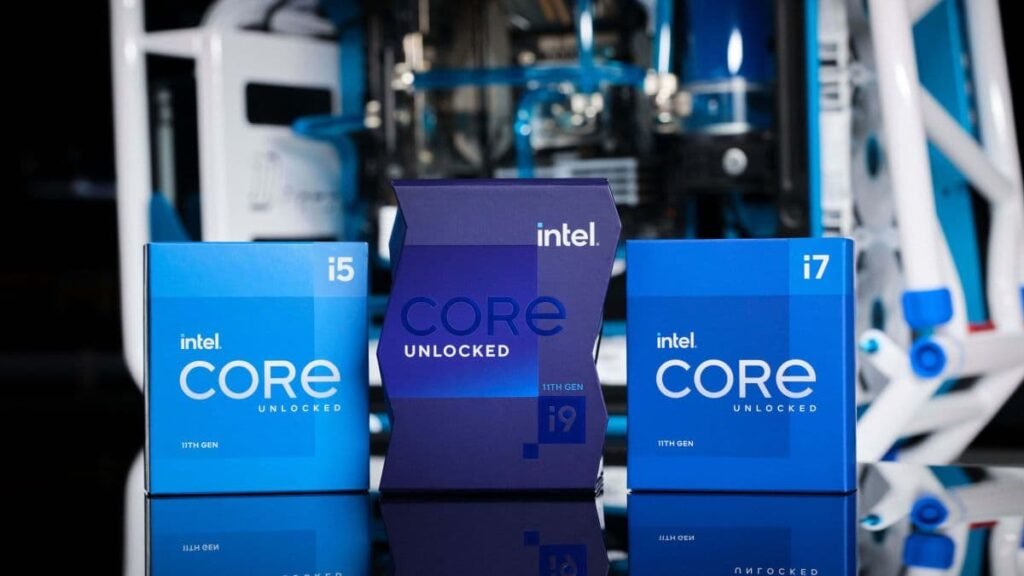Intel’s 11th Gen
Intel’s next-generation desktop processors are finally here: after a sneak peek at CES, the company is revealing Intel’s 11th Gen Core desktop processors in full (better known by their codename, Rocket Lake-S.)
The Intel Core i9-11900K, with eight cores and 16 threads, improved clock speeds up to 5.3GHz, support for DDR4 RAM at 3,200MHz, a total of 20 PCIe 4.0 lanes, and backwards compatibility with Intel’s 400 Series chipsets, is the chip to beat.
Downgrade
On paper, the latest chip is a downgrade from last year’s top iteration, the Core i9-10900K, which had 10 cores and 20 threads (and a similar boosted clock speed of 5.3GHz).
That’s because, with its 11th Gen Rocket Lake-S chips, Intel is launching Cypress Cove, a modern desktop core architecture for the first time in over a decade. The Skylake microarchitecture, which the company has been using since its 6th Gen chips in 2015, has finally been replaced by Cypress Cove.

However, the Cypress Cove design is based on Intel’s Willow Cove chip designs and technologies, which the company has been using on its Intel’s 11th Gen 10nm Tiger Lake chips and which Intel is now backporting to its 14nm production process.
10nm Chips
However, since those designs were intended for 10nm chips, Intel is constrained in the number of cores it can fit when scaling them up to a 14nm size; hence, the year-over-year decrease in core count. However, Intel believes that the latest chips would outperform the 10th Gen (at least in some cases), with the core architecture allowing for up to 19% more IPC (instructions per cycle) than the previous version.
Intel’s point here is that having a lot of cores isn’t enough; frequency speed and efficiency are also important, and thanks to the sophistication of the 14nm manufacturing process, Intel is very good at getting every last bit of performance out of these chips.
| Model | Cores/Threads | Base clock speed (GHz) | Boosted clock speed (GHz) | Turbo Boost Max 3.0 clock speed | Thermal Velocity Boost speed, single core / all cores (GHZ) | Smart Cache | TDP (W) | Graphics | Recommended Price |
|---|---|---|---|---|---|---|---|---|---|
| i9-11900K | 8/16 | 3.5 | Up to 5.1 | Up to 5.2 | Up to 5.3 / 4.8 | 16M | 125 | Intel UHD Graphics 750 | $539 |
| i9-11900 | 8/16 | 2.5 | Up to 5.0 | Up to 5.1 | Up to 5.2 / 4.7 | 16M | 65 | Intel UHD Graphics 750 | $439 |
| i7-11700K | 8/16 | 3.6 | Up to 4.9 | Up to 5.0 | NA | 16M | 125 | Intel UHD Graphics 750 | $399 |
| i7-11700 | 8/16 | 2.5 | Up to 4.8 | Up to 4.9 | NA | 16M | 65 | Intel UHD Graphics 750 | $323 |
| i5-11600K | 6/12 | 3.9 | Up to 4.9 | NA | NA | 12M | 125 | Intel UHD Graphics 750 | $262 |
| i5-11600 | 6/12 | 2.8 | Up to 4.8 | NA | NA | 12M | 65 | Intel UHD Graphics 750 | $213 |
| i5-11500 | 6/12 | 2.7 | Up to 4.6 | NA | NA | 12M | 65 | Intel UHD Graphics 750 | $192 |
| i5-11400 | 6/12 | 2.6 | Up to 4.4 | NA | NA | 12M | 65 | Intel UHD Graphics 730 | $182 |
And (obviously) Intel’s benchmarks back up this claim: when compared to last year’s Core i9-10900K, the i9-11900K outperformed the i9-10900K by 8 to 14 percent in games like Gears 5, Grid 2019, Microsoft Flight Simulator, and Total War: Three Kingdoms. Intel’s top cpu, too, claims to outperform AMD’s flagship Ryzen 9 5900X processor in those sports, albeit by smaller margins.
4k Benchmarks Awaited
However, since Intel’s tests were all run at 1080p, we’ll have to wait for more extensive benchmarking on a wider range of titles — and particularly at 4K resolution — in the future.
Other advantages of the new architecture include up to 50% improved integrated graphics compared to Gen9 due to the company’s new Xe graphics, which have one-third more EUs than Gen9 graphics.
That isn’t the most revolutionary improvement, given that these are laptop chips that would almost definitely be combined with a high-end discrete graphics card. Although Intel will sell a few F-series versions of the new chips without GPUs, the overall design of those models will remain the same. That means, at least for the time being, Intel will not sell any niche versions that do away with integrated GPUs in order to fit in more cores.
Upgrades
Other upgrades are included in the new chips. The Intel’s 11th Gen chips add Resizable BAR, for a frame rate boost on compatible Nvidia and AMD graphics cards. There’s support for both USB 3.2 Gen 2×2 at 20Gbps and Intel’s own Thunderbolt 4, as well as DDR4-3200 RAM, built-in. Intel has also introduced four more Gen 4 PCIe lanes, bringing the total to twenty.
Intel is also launching its 500 series motherboards alongside the latest processors, as is customary with a big new chip launch, but the Rocket Lake-S CPUs will also be backwards compatible with 400 series motherboards.
Additionally, the new chips come with some new overclocking solutions for users who want to get even more power out of them. Along with the Intel’s 11th Gen chips, Intel’s Extreme Tuning Utility program will be upgraded with a revamped user interface and new functionality.
Latest Intel’s 11th Generation desktop processors are now available.
